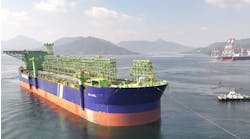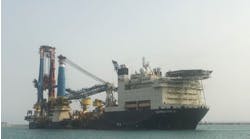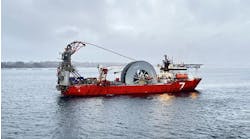DEEPWATER ECONOMICS How pigging operations impact deepwater production economics
Propulsion fluid, path design, entry and exit, material disposal considerations in pigging design
Glen E. Lochte
Tony Kozel
H. 0. Mohr Research & Engineering
- Ideal offshore pigging situation.
- Example of deepwater pigging situation.
- Subsea production system building blocks with potentially piggable passages.
- Types of subsea production systems.
- Manifold system diagram.
- Configuring a field development to accommodate riggings.
Pigging of production flow paths has a significant effect on deepwater production economics. Deepwater production systems, referred to within this paper, include simple systems such as one or more remote subsea wells supported by a surface facility not located over the wells. Also included are multiple wells beneath a minimum surface facility which transports commingled minimally treated production fluid to a primary process facility located out of field.
Deepwater production systems may be characterized in a few areas key to the effects upon pigging technology.
- Long distances of 30-60 miles from deepwater production to complete surface production processing facilities are typical.
- Cold temperatures tend to create deposits on inner pipe walls of fluid passages. Paraffins and hydrates are of particular concern.
- Large investments are required in the production system prior to first production.
- Unplanned modifications to the production system, particularly subsea production systems, are virtually impossible to predict from an economic viewpoint.
- Seabottom intervention to a pipeline requiring surface support is a very expensive operation.
- Use of flexible pipe for connection jumpers, risers, and flowlines is prevalent.
The effects of the above characteristics will be discussed in the following text.
Pigging support
The ideal offshore pigging situation is well defined and can be performed routinely with high reliability. The deepwater pigging situation is generally less than ideal. The deepwater production system has the following pigging requirements from the system, many of which have economic implications:
- Source of fluid: If pigging is in the direction of normal flow and the pig is introduced into the flow stream, source fluid is not a problem. In pigging loop systems, a source of fluid is required to fill the leg of the loop going out to the production source. Given the long distances in some systems, the source of fluid has economic implications due to purchased fluid and/or loss of production.
- Source of propulsion: Various pigs function best when traveling at 4-10 miles per hour. This requirement often cannot be met by normal flow from wells, resulting in compromised pigging efficiency or a large pumping system in a weight-sensitive structure.
- Entry point: The optimum pigging situation is to enter through a launcher at the surface and pig in the direction of normal flow through a smooth passage to a receiver, also located at the surface. For remote subsea production systems, pigging may create the dilemma of either having an expensive extra flowline(s) in order to create a pigging loop from the surface, or requiring a subsea pig launcher at the production source which will require periodic and expensive intervention by a surface supported system.
- Path requirements: The path requirement for pigging can be a complicated and limiting factor for deepwater production systems. Many flow passages are comprised of steel pipe as well as flexible pipe which present dimensional incompatibilities, since flexible pipe is usually sized differently than steel pipe. For pipeline applications, flexible pipe is generally limited to smaller sizes than steel pipe. In addition to dimensional incompatibilities, flexible pipes are also quite limited regarding the types of pigs which can pass through, particularly scrapers or pigs containing wire brushes.
- Exit point: The exist point for pigging is ideally at the surface. There are certain configurations, however, which may require subsea pig receivers, such as pigging through a branch line up to a trunk line, or through a steel pipeline up to the base of a flexible riser. The extra capital costs for constructing and installing a subsea pig receiver, as well as the operating costs of any associated surface supported systems required to periodically retrieve the receiver are additional considerations in the field development.
- Disposal: The disposal of pigged material and fluid is a concern in limited surface facilities. There is an economic trade off between frequent pigging with relatively small disposal requirements, versus infrequent pigging with larger amounts of material, such as hard paraffin, to dispose of.
The optional configurations of subsea production systems can be broken down into nine basic building blocks. Every one of the basic building blocks may be affected by pigging.
The components in the production system subject to pigging requirements are the fluid carrying portions of the system. These can include tree piping, manifold piping, flowlines, and risers. Naturally, all valves and fittings associated with the piping must be compatible with the selected pigging operations and equipment. Bends, tees, wyes or other changes in internal diameter or configuration are subject to special provisions for piggability.
The export riser and pipeline may also require pigging. This may be a fairly conventional operation unless the export riser contains flexible pipe which can place a limitation on the types of pigs available for use and perhaps require more frequent pigging to compensate for the subsequent loss in optimum pigging effectiveness in the steel export pipeline.
Water injection lines, once thought to not require pigging, are now considered candidates for utility pigging and perhaps intelligent pigging.
Deepwater development
Pigging requirements must be considered from the beginning of field development. Some field development options do not lend themselves to routine pigging without special, perhaps costly, unreliable provisions .
An example of a field development option exhibiting difficult pigging requirements is a remote subsea manifold surrounded by several remote subsea satellite wells, which require pigging through the tree piping.
Pigging under these conditions requires either frequent surface supported intervention at a number of subsea pig launchers, or a very complex multi-lobed loop with multiple pigging diverters and isolation valves.
Pigging situations may be organized into two general groups. When considering field development options, a chart of the two groups will aid in configuring the pigging portion of the system.
Pigging requirements influence both capital cost estimates and operating costs as field development options are considered. During design, pigging requirements are part of the design basis which must be included throughout the system.
The land integration testing should include procedures to assure that the system is piggable as required. Operability of the system will be dependent upon workable pigging procedures. They must be considered in detail during the system design.
Once put into operation, the most reliable means to determine the utility pigging frequency required is initially to pig frequently, while monitoring pigged materials. During the first year of operation, the pigging frequency can be optimized. Some fields, however, change in pigging requirements during field life.
Long distances
Pigging distances of 30-60 miles between the surface facility and the remote subsea facility present major economic considerations. Assuming that a pigging loop is used, the total length of the loop would be 50-120 miles.
If a pigging speed of 4 mph is used, the actual pigging time would be 15-30 hours. During pigging, production would have to be shut in or cut back. The final frequency of pigging required obviously has a profound effect on production.
The large volumes of fluids required for pigging are also of economic interest. Dead crude is a favored candidate fluid in oil systems. Its use in pigging will delay the sale of this fluid, and will likely necessitate shutting in production during pigging operations since it is probably only available at a much reduced pressure.
Subsea intervention
Two subsea intervention requirements associated with pigging can have significant economic effects. The direct requirement of running and retrieving subsea pig launchers or receivers is significant. Assuming that the launcher or receiver is located remote from a permanent overhead facility, the mobilization-demobilization costs, vessel costs, etc., increase directly with pigging frequency. In addition, there are service systems (running tools, umbilical) which may be unique to the system and require maintenance and replacement.
A second intervention requirement related to pigging relates to the information received from intelligent pig surveys. The information regarding metal loss, coating loss, overburden loss, pipe movement, etc. is impressive. The resolution, interpretation, and accuracy of location anomalies has advanced dramatically during the last decade.
The cost in preparation of the pipeline and the service of intelligent pigging is significant. The difficulty in deepwater may be what to do with the information. A simple-minded response to intervene at every anomaly indicated by the intelligent pig is inappropriate, since each deepwater intervention is likely a million dollar plus event. Conversely, avoiding the opportunity to gather quality information, allowing determination of trends may also be inappropriate. In either case, information available by pigging is involved in the issue.
Flexible pipe
The use of flexible pipe is integral to many configurations of deepwater production systems. The integrity of the flexible pipe is key to the production system integrity, since flexible pipe is commonly used in critical areas such as flowline jumpers near the tree. The high fatigue applications of high pressure risers also often use flexible pipe. Key characteristics of flexible pipe are loss of plasticizer in the primary pressure barrier and the integrity.
The intelligent pig technology which has advanced and been refined for steel pipelines simply doesn't apply to flexible pipe. The primary means for gauging the integrity of flexible pipe are periodic pressure testing and visual inspection of the outside surface.
Technology is under development to provide in-situ integrity inspection.
Historically, flexible pipe has been ordered to a significantly higher specification than actual anticipated requirements. Long term successful field experience exists with flexible pipe. Major current field developments utilize flexible pipe extensively, demonstrating confidence in the product and creating a market for new pigging technology unique to this deepwater requirement.
Conclusions
Pigging has a profound effect on some production system configurations. The frequency of pigging is a primary variable which can drastically alter the provisions required for pigging.
The required frequency of pigging is difficult to specify in advance. Wherever practical, frequent pigging during early production, followed by a reduction in frequency according to pigging returns analysis is preferred. Some reservoir characteristics change, however, and may require different pigging techniques late in the field life.
The economics of providing flow and returns handling for pigging may be more critical than providing a smooth path for the pig in long distance flowlines and gathering lines.
The consequences of not pigging, and perhaps making no provisions for pigging until some gross indication of problems are apparent, is not preferred in deepwater long lines. The result can be a line plugged by a stuck pig or accumulated deposits. This can result in expensive production interrupts, extended remedial treatment, or even line replacement.
AUTHORS
Glen E. Lochte (PE) is vice president of H. O. Mohr Research & Engineering. He has 25 years experience in offshore operations, much of it focused on subsea production facilities and pipelines in the North Sea and Gulf of Mexico. He holds a dozen foreign patents.
Tony Kozel is a design engineer with H. O. Mohr Research & Engineering with a background in subsea production and controls. He recently led Mohr's effort in pigging technology assessment for the DeepStar and specified the pig launching system for the Enserch 388 project.
Copyright 1995 Offshore. All Rights Reserved.


